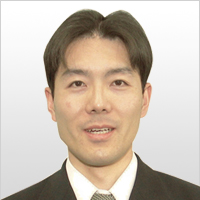Naoki Fukata

- Affiliation:
- Inorganic Nanostructures Unit, Semiconductor Nanostructured Materials Group, Group Leader
- Specialty:
- Semiconductor Physics
- Academic degree:
- Ph.D. University of Tsukuba (1998)
- Recent publications
- See NIMS Researchers DB
Educational and Working History
| 2011-present | MANA Scientist, Group leader of Semiconductor Nanostructured Materials Group, MANA, NIMS and PRESTO Researcher, JST | 2007-2010 | Independent Scientist, MANA NIMS and PRESTO Researcher, JST |
2006 | Senior researcher, Advanced Electric Materials Center, NIMS |
2005 | Senior researcher, International Center for Young Scientists & Nanomaterials Laboratory, NIMS |
2002 | Lecturer, Institute of Applied Physics, University of Tsukuba |
1998 | Research associate, Institute for Materials Research, Tohoku University |
1998 | Ph.D. University of Tsukuba |
|---|
Research Interests
Nanocrystalline materials
He is synthesizing zero- and one-dimensional semiconducting nanostructures and investigating their physical properties. In particular, Si nanowires with one-dimensional nanostructures are very expected for building blocks for next generation nano-electrical devices. Recently, he succeeded in the impurity doping into silicon nanowires to add new functionalities. He proved that impurity atoms such as boron and phosphorus atoms, which are the most important dopants in Si, could be doped in the crystalline Si core of Si nanowires and electrically activated in the sites for the first time by micro-Raman scattering and electron spin resonance techniques. He also succeeded in inducing the stress in Si nanowires by thermal oxidation and detecting the stress by micro-Raman scattering measurements. This technique will be important for the enhancement of carrier mobilities in silicon nanowires. energy surface, which is crucial for study on excited states dynamics. Improvement of accuracy and increase of applicability of these methods as well as developments of other techniques are my current projects in MANA, NIMS.
Hydrogen in Si
The H2 was called hidden H states in Si for a long time. In 1996, he and his collaborators successfully proved that hydrogen atoms introduced into Si crystals exist as H2 molecules experimentally by Raman scattering measurements for the first time. He got two awards related in the hydrogen research.
In situ diagnostic of defects formation
He and his collaborators developed in situ spectroscopic measurements and succeeded in detecting the defects formation in SiO2 directly during femtosecond laser irradiation. Based on the result, he got an award named Corbett award.
Selected Papers
-
- Phosphorus doping and hydrogen passivation of donors and defects in silicon nanowires synthesized by laser ablation
- N. Fukata, J. Chen, T. Sekiguchi, S. Matsushita, T. Oshima, N. Uchida, K. Murakami, T. Tsurui, and S. Ito
- Appl. Phys. Lett., 90, (2007) 153117.
-
- Doping and hydrogen passivation of B in silicon nanowires synthesized by laser ablation
- N. Fukata, J. Chen, T. Sekiguchi, N. Okada, K. Murakami, T. Tsurui, and S. Ito
- Appl. Phys. Lett., 89, (2006) 203109.
-
- Formation of hydrogen-boron complexes in boron-doped silicon treated with a high concentration of hydrogen atoms
- N. Fukata, S. Fukuda, S. Sato, K. Ishioka, M. Kitajima, T. Hishita, and K. Murakam
- Phys. Rev. B, 72, (2005) 245209.
-
- Phonon Confinement effect of Silicon Nanowires Synthesized by Laser Ablation
- N. Fukata, T. Oshima, K. Murakami, T. Kizuka, T. Tsurui, and S. Ito
- J. Chem. Phys., 126, (2007) 204506
-
- In situ spectroscopic measurement of Transmitted light related to defect formation in SiO2 during femtosecond laser irradiation
- N. Fukata, Y. Yamamoto, K. Murakami, M. Hase and M. Kitajima
- Appl. Phys. Lett., 83, (2003) 3495.








